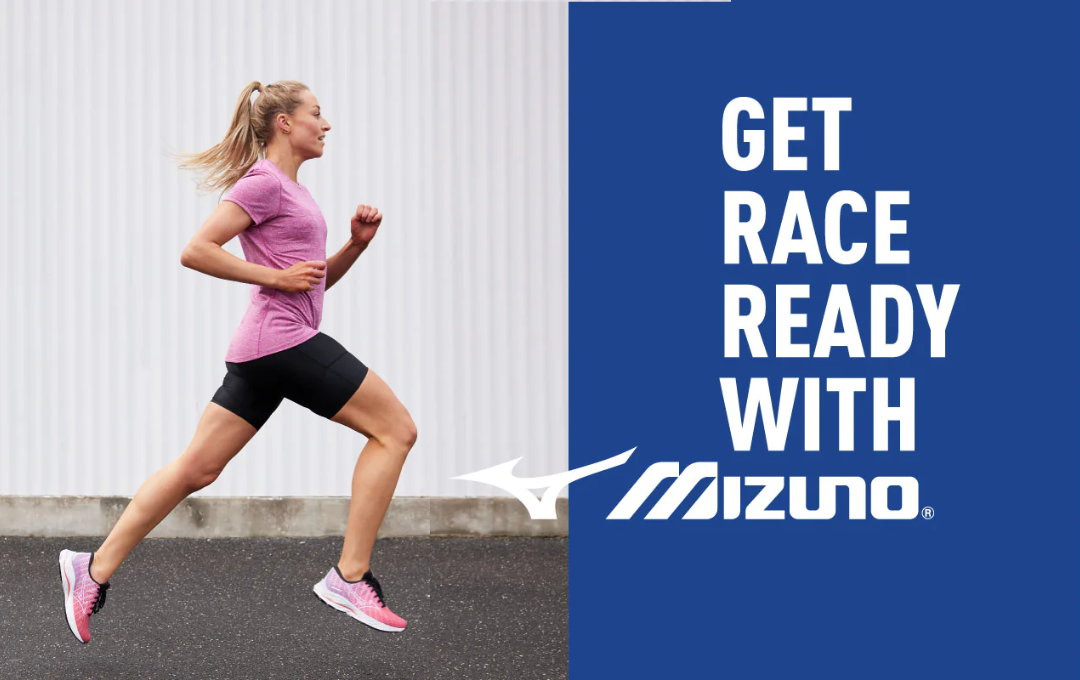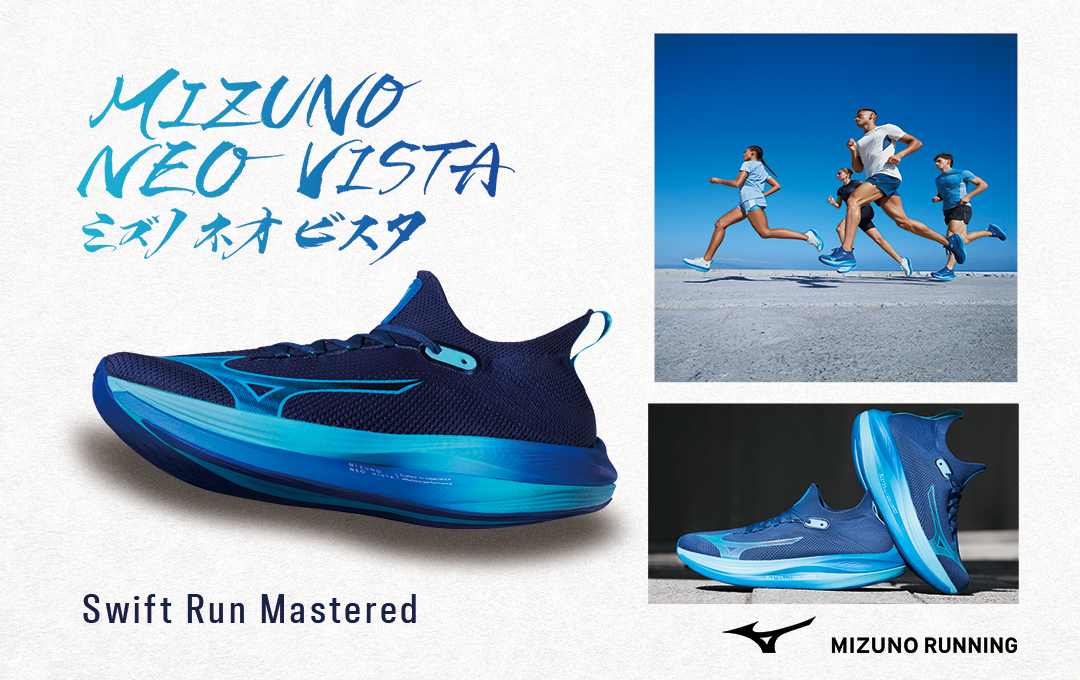GET RACE READY WITH MIZUNO

TIPS FOR A FIRST-TIME RUNNER
(FROM A FIRST-TIME RUNNER)
Running can seem quite daunting for a first timer. The pressure of distance and pace can make anyone not want to start at all, even technique and how you look while running can be intimidating. With a seemingly easy exercise there can be so many thoughts and hesitations involved.
If you are new to running and just want to get started but don't know how, here are some simple yet effective tips to help you take your first steps!
(1) START EASY
Don’t expect to be able to run 5km first go, this is something to build towards. Start with a short distance and don’t feel pressured to run the whole time. Aim to run 200m then walk 100m, a good way to track this is to use light posts or trees as markers. Set your eyes on your target and reach that then take a rest walking then start again to the next target. Eventually you will be able to shorten your walking time to keep a continual jog.
(2) DON'T THINK ABOUT PACE
If you try to run too fast too quickly you will burn out and not make your full distance. Keep a steady pace and then later you can build up speed.
(3) FOLLOW A TRAINING PLAN
Having a set plan/program will help you stay on track and motivated. It will be more efficient in your use of running/workout time. It’s also like a to do list, satisfying to tick off after completely each run/workout. I always find knowing when it will be over helps me get through it!
(4) RUN IN A GROUP
Running and training with a friend helps with motivation and accountability, they are someone to lean on when you need that extra push. Having a run buddy keeps it fun! There are also many running squads and groups around who always love to welcome new members.
(5) MUSIC
Find a good playlist to keep you company and upbeat while you run. Time goes faster with a good song.
(6) NUTRITION
Make sure you are eating enough nutritious food. Food is fuel for your body and it is important to keep energy levels high, otherwise workouts will feel harder.
(7) MAKE SURE YOU USE THE RIGHT GEAR
As with any activity, having the right gear will help. Not every sneaker is designed for running, it is important you are wearing shoes with the right support and cushioning for you. Your feet and joints will thank you later!
Also important to invest in good quality leggings, running socks, crop tops and long sleeve tops (cold days and early mornings). This will keep you comfortable and avoid rubbing.
Most importantly, enjoy, have fun and don’t put too much pressure on yourself! It’s a long but rewarding process!
__________________________________________________________________________________________________________________________________________________________________
WHICH IS THE BEST RUNNING SHOE FOR ME?
So, you have signed up for the event, maybe even started some training? If you haven’t already it’s time to start thinking about your footwear – shoes might be the single most important tool in helping you cross the finish line (and as comfortably as possible!)
Looking at a page of shoes online can be overwhelming, there are so many types of support, cushioning, foams and plates (not to mention colours!)
We have compiled a list of a few key things to consider when choosing your next pair of shoes:
SUPPORT V NEUTRAL
Mizuno make shoes that sit on a spectrum from Neutral on one end to Supportive on the other, so which one is right for you? Some people like support shoes, some people need the additional support under their arch because they roll in, others might roll out and need a more neutral shoe. For those that wear orthotics a neutral shoe is often best to provide a good platform for their orthotic to work with. To know which category of shoe is best suited to your foot type we recommend seeing a Podiatrist or Physio for a gait assessment, or you can head in to a specialty running store for an analysis.
CUSHY / SOFT V RESPONSIVE / FIRMER
Again, the feeling you want underfoot often comes down to preference, some like a softer foam that gives them the sense of ‘floating’, whereas others like to feel the road and have a more ‘propulsive’ ride. Mizuno makes shoes that offer these different sensations so that you achieve the level of cushioning that suits your running style.
SHOE ROTATION
It can be beneficial to have a couple of pairs in your rotation, a training shoe that provides adequate protection and cushioning for you, for those bigger mileage and longer run days and then a lighter, faster type of shoe for your speed sessions and the race day itself. Whilst two shoes are not essential to see you through both your training and race day it could be something you consider.
PLATED SHOES - WHAT'S THE HYPE?
Everyone's talking about plated shoes! They are certainly a topic of conversation amongst runners these days thanks to the rise of ‘super shoes.’ Whilst these shoes are normally favoured by the more elite runners, Mizuno shoes have for the last 30 plus years used ‘Wave Plates’ as their signature technology in all of their performance running shoes. For Mizuno this technology provides both support and cushioning allowing their shoes to be lighter and more durable.
What’s the research say? Well today we are all about the comfort factor – the shoe you feel the most comfortable in is likely to provide you with the best running outcomes. We recommend heading into store or getting in touch with us if you have any questions around fit, function and form!
__________________________________________________________________________________________________________________________________________________________________
TRAINING PLAN
While it may be tempting to push as hard as you can, it is true that slow and steady wins the race. The best way to get to the start line injury free and ready to run is by slowly increasing distance and pace over time, so your body has time to adjust and grow stronger through the process.
Luckily our Team Mizuno coaches have created 12-week programs to build you up to race distance slowly and safely, setting you up for a perfect race day.
Just remember although it may get tough at times, enjoy the process. Running can be fun, and nothing is going to beat that finish line feeling on race day.
MIXING IT UP
You’ll notice that all of the programs contain sessions like “Hill Reps” & “Sprints” what is that about? These are all about increasing your speed and aerobic capacity, giving the body different challenges helps you to continue to adapt and improve and will give you the strength and endurance to get through the race on the day.
__________________________________________________________________________________________________________________________________________________________________
NUTRITION ADVICE
BY CHLOE MCLEOD
PRE RACE FUEL
Consume a meal 1-4 hours before your race. Ensure this meal is familiar and you have practiced it in training prior to prevent gastrointestinal issues during the race.
• With 2-4hrs available pre-race, aim to include a main meal which includes a low-GI source of carbohydrate and moderate amount of protein.
• -2hrs available pre-race, aim to include a high-GI, carbohydrate rich snack that is low in fibre, fat and protein. If you have time for a main meal, you can also use this opportunity to top-up your fuel stores with an additional snack.
What about the night before? Enjoy a meal rich in carbs, lower in fibre that you have tried multiple times through training. Pasta, home made pizza, or a rice based dish are all winners.
DURING RACE CARBS
Your body can only store around 2000 calories (~8400kJ) of energy from carbohydrate. Once this is depleted, you will no longer be able to sustain the intensity you were performing at when fuelled by carbohydrate. Consume familiar sources of carbohydrate during the race (i.e. practiced in training) A good rule of thumb to go by is consuming a source of carbs (such as a gel or sports drink) every 30-40mins.
Its important to remember there is a big difference between fuelling to optimise performance, and fuelling because you need to. Sure, you might be able to run 21.1km without taking anything on board, but, will you run faster if you do? Most likely you will.
POST RACE RECOVERY/SNACKS
Nutrition plays an important role in recovery
As soon as possible following the race, consume a high-quality protein source to aid muscle recovery and a carbohydrate option to replace depleted carbohydrate stores.
Within 4hrs, consume a recovery meal that includes carbohydrate, protein, colour and healthy fats to support and enhance recovery.
GENERAL TIPS FOR RACE DAY FUELLING
• You play the way you train - You must practice all nutrition strategies in training first, nothing new on race day.
• Consume a main meal 2-4 hours before your race start time.
• This allows time for your body to digest the food you've eaten so it's available in the bloodstream to be easily utilised during the first section of your run.
• This meal should be high carbohydrate, moderate to low protein, and low in fat.
• Examples could include: toast with vegemite or banana and honey, a fruit and yoghurt smoothie, porridge with banana and honey, or a light cereal.
• Consider these factors when planning your hydration plan:
• Weather and humidity levels
• Available aid stations
• Palatability of fluids over the duration of the race (i.e. sweet vs. savoury options)
• Be organised! Don't rely on the aid stations for your fuelling and hydration needs, as these alone will be unlikely to meet your requirements for the duration of the race. Be organised with your own snacks and fluids and plan where you will have these available on the course from your support team.
• Eat to the clock. You might get distracted and your appetite is likely to be very poor during the race, but fuelling is still important to help keep you on the course. Set timers on your watch as reminders of when to take on board some food and fluids rather than relying on hunger cues.
By Chloe McLeod, Advanced Sports Dietitian, Director and Principal Dietitian at Verde Nutrition Co
__________________________________________________________________________________________________________________________________________________________________
WHAT TO EXPECT ON RACE DAY
It has finally come; all your hard work and preparation has led to this day. No doubt there will be some pre-race jitters but we have the plan in place to help you overcome them so when you hit the starting line you’re rearing to go. After all remember the most important thing, racing is meant to be fun so be sure to enjoy yourself and embrace the vibe and the atmosphere on race day.
WHAT TIME TO ARRIVE
We recommend you arrive 45 minutes to 1 hour before your scheduled race start. Reason being its important to get there early enough to find a park and to give you time so you’re not scrambling around stressed trying to figure out where you need to be. You also want to give yourself enough time to stretch, warm up and go to the bathroom (if nature calls). You want to get yourself a good spot at the starting line too, it can often take several minutes to get through the waves of participants so the longer you have to wait the longer the jitters.
WARM UP PREPARATION
Ensuring you are warmed up for your run is quite important to increase blood flow and oxygen to your muscles to help you perform at your best. The ideal pre-race warm up may be different for each individual but the last thing you want to do is tire yourself out so getting that balance right is key. A solid warm up consists of slow jogging, stretching as well as some small doses of intense movements.
RACE DAY NUTRITION
Advanced Sports Dietitian, Chloe Mcloed says you should consume a meal 1-4 hours before your race. Ensure this meal is familiar and you have practiced it in training prior to prevent gastrointestinal issues during the race.
• With 2-4hrs available pre-race, aim to include a main meal which includes a low-GI source of carbohydrate and moderate amount of protein.
• 1-2hrs available pre-race, aim to include a high-GI, carbohydrate rich snack that is low in fibre, fat and protein. If you have time for a main meal, you can also use this opportunity to top-up your fuel stores with an additional snack.
• During the Race, consume familiar sources of carbohydrate during the race (i.e. practiced in training) A good rule of thumb to go by is consuming a source of carbs (such as a gel or sports drink) every 30-40mins.
• As soon as possible following the race, consume a high-quality protein source to aid muscle recovery and a carbohydrate option to replace depleted carbohydrate stores.
• Within 4hrs, consume a recovery meal that includes carbohydrate, protein, colour and healthy fats to support and enhance recovery.
It’s important to remember there is a big difference between fuelling to optimise performance, and fuelling because you need to. Sure, you might be able to run 21.1km without taking anything on board, but, will you run faster if you do? Most likely you will. Click here for Chloe’s in-depth nutrition guide.
RACE MAP
We highly recommend downloading the race map for the event you are competing in well in advance. This will help you get your head around the course you’ll be running, where the key drink stops are, toilets and first aid. Finding the map is super easy, they can usually be found on the event website and will also be emailed you in the lead up to race day.
POST RACE
So you’ve made it to the line! Congratulations it’s now time to celebrate with all your friends and family on an awesome achievement. There’s no better feeling than crossing that finish line. You’ll receive some cheers behind the rails from some of your closest fans, you’ll get offered some energy bars, a drink and some fruit to help with recovery and then you’ll be given a medal to commemorate all your hard work that’s lead you to this moment. Be sure to get a snap showing off your medal a hit a local café or bar for a well-earned celebratory drink on your way home.



